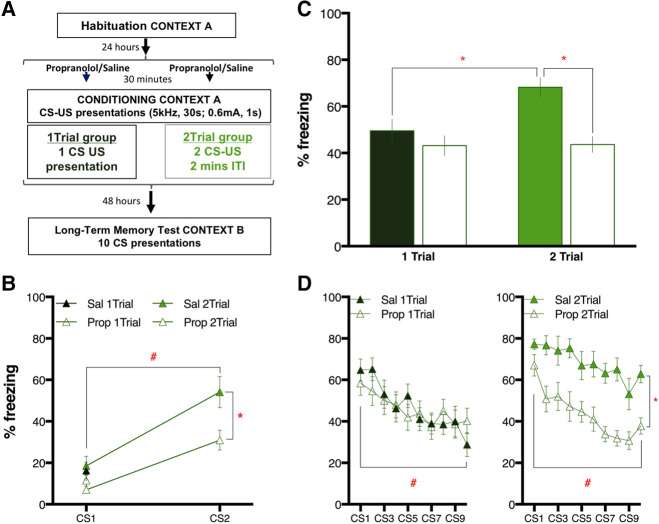Figure 1.
Long-term threat memory (LTM) is impaired by pretraining propranolol (10 mg/kg) in animals conditioned with 2 CS–US pairing trials but not in animals that received 1 CS–US trial. (A) Schematic of the experimental design. Animals were habituated to the conditioning context for 30 min. Twenty-four hours later, rats received propranolol (10 mg/kg: Prop: empty symbols) or saline vehicle (1 mL/kg, Sal: filled symbols) 30 min before the conditioning session, which consisted of either 1 CS–US pairing trial (1Trial: dark green) or two trials (2Trial: light green) with a 2-min intertrial interval (ITI). Forty-eight hours later, LTM was tested in a modified context with 10 CS-alone presentations. (B) Graph showing the average percentage of freezing (mean ± SEM) to each CS presentations during threat conditioning session for each set of animals. In the group conditioned by presenting two CS–US pairings, the animals treated with propranolol froze less than their controls to the CS2. (C) Percentage of freezing (mean ± SEM) averaged across all 10 CSs presented to test LTM. Post hoc tests after finding significant main Drug Treatment and Trial effects as well as Treatment by Trial interaction revealed that the saline animals conditioned with 2Trials froze more that the 1Trial ones. Propranolol reduced the amount of freezing only in the 2Trial group. (D) The percentage of freezing (mean ± SEM) to each of the 10 CSs presented for LTM test divided by treatment. The 1Trial (left graph) and the 2Trial (right graph) groups showed main effects of CS presentation indicating normal within-session extinction learning. 2Trial animals also showed a main effect of the treatment. (*) P < 0.05, (#) P < 0.05 for CS main effect.

